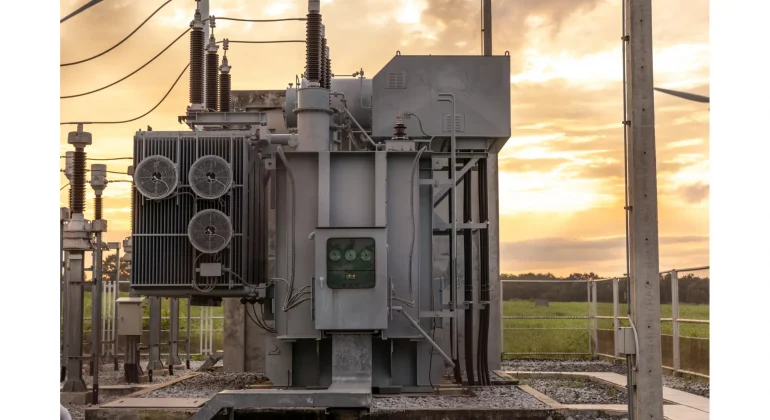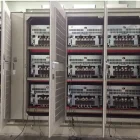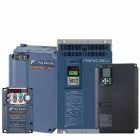Dissolved Gas Analysis (DGA) is a critical diagnostic tool to assess oil-filled electrical transformers‘ health. By analyzing the gases dissolved in the transformer oil, DGA helps identify potential faults early, preventing costly failures and ensuring the reliability of power distribution systems. This method is essential for maintaining transformer health because it detects issues before they escalate into major problems, thereby reducing downtime and extending the lifespan of transformers.
Basic Principles: How Gases Dissolve in Transformer Oil
Gases dissolve in transformer oil as a result of electrical and thermal faults within the transformer. These faults can arise from overheating, arcing, or insulation breakdown, leading to the generation of various gases. The types and concentrations of these gases provide valuable insights into the transformer’s condition, allowing for targeted maintenance actions.
The Significance of Early Fault Detection Through DGA
Early fault detection through DGA is vital for preventing transformer failures. By identifying potential issues early, utilities and industries can avoid unplanned downtime, reduce maintenance costs, and ensure continuous power supply. This proactive approach not only saves resources but also enhances the overall reliability of electrical distribution systems.
The Economic Impact of Proactive Maintenance vs. Reactive Repairs
Proactive maintenance through DGA significantly reduces the economic impact of transformer failures. While reactive repairs can lead to substantial financial losses due to equipment replacement and power outages, proactive maintenance minimizes these costs by addressing issues before they become critical. Investing in regular DGA and maintenance is a cost-effective strategy that ensures the longevity of transformers and maintains operational efficiency.
The Gases and Their Significance
Key Gases Analyzed in DGA
- Hydrogen (H2): Indicates arcing or partial discharge within the transformer.
- Methane (CH4): Suggests thermal faults.
- Ethane (C2H6): Associated with overheating.
- Ethylene (C2H4): Indicates severe overheating or hot spots.
- Acetylene (C2H2): Points to high-energy arcing.
- Carbon Monoxide (CO) and Carbon Dioxide (CO2): Indicate cellulose degradation.
- Oxygen (O2) and Nitrogen (N2): Reflect oil quality and air presence in the transformer.
Understanding the Relationship Between Gas Concentrations and Fault Types
The concentration and combination of gases provide crucial information about the type and severity of faults within the transformer. For example, high levels of hydrogen and acetylene may indicate arcing, while elevated ethylene and methane levels suggest overheating. Understanding these relationships allows for precise fault diagnosis and targeted maintenance strategies.
Typical Gas Generation Rates
The rate at which gases are generated can vary based on the fault type and severity. For instance, thermal faults tend to produce methane and ethane, while arcing faults generate hydrogen and acetylene. Monitoring these gas generation rates helps in assessing the transformer’s condition over time and in making informed maintenance decisions.
DGA Interpretation Methods
Key Interpretation Techniques
Dissolved Gas Analysis (DGA) relies on several key techniques to interpret the data collected from transformer oil samples. These methods help in identifying potential faults and determining their severity:
- Key Gas Method: Focuses on the concentration of specific gases to diagnose faults. It is straightforward but may not provide detailed insights into complex fault conditions.
- Rogers Ratio Method: Uses ratios of gas concentrations to identify fault types. It is widely used but can sometimes yield ambiguous results if gas levels fall outside specified limits.
- Duval Triangle Method: Offers a comprehensive approach by plotting gas concentrations on a triangular graph. It is effective for identifying a wide range of faults without unresolved diagnoses.
- Doernenburg Ratio Method: Similar to Rogers, it uses gas ratios but is less commonly applied due to its limitations in handling certain fault types.
Strengths and Limitations of Each Method
Each DGA interpretation method has its strengths and limitations:
- Strengths:
- Key Gas Method: Simple and easy to apply.
- Rogers Ratio Method: Widely recognized and used.
- Duval Triangle Method: Comprehensive and avoids unresolved diagnoses.
- Doernenburg Ratio Method: Useful for specific fault types.
- Limitations:
- Key Gas Method: May not capture complex faults.
- Rogers Ratio Method: Can yield ambiguous results if gas levels are outside specified limits.
- Duval Triangle Method: Does not detect incipient faults well.
- Doernenburg Ratio Method: Less versatile compared to other methods.
Importance of Trend Analysis and Historical Data
Trend analysis and historical data are crucial for accurate DGA interpretation. By monitoring changes in gas concentrations over time, utilities can identify emerging faults before they become critical. Historical data helps in establishing baselines for normal gas levels, allowing for more precise fault detection and prediction.
Using Software to Interpret DGA Data
Software tools, such as MATLAB GUI or machine learning-based systems, enhance DGA interpretation by combining multiple methods and providing visual insights into fault types. These tools improve accuracy and consistency by integrating various interpretation techniques, making diagnosing complex faults easier and predicting future issues.
Practical Aspects of DGA Implementation
Sampling Procedures
Proper sampling is essential for accurate DGA results:
- Proper Sampling Techniques: Ensure that samples are taken in clean, moisture-free containers to prevent contamination.
- Frequency of Sampling: More critical transformers require more frequent sampling to ensure early fault detection.
- Safety Precautions: Always follow safety guidelines during sampling to avoid accidents.
Laboratory Analysis
Choosing a reliable laboratory is vital for accurate DGA results:
- Choosing a Reliable Laboratory: Select labs with experience in DGA testing and a track record of accurate results.
- Understanding the Laboratory Report: Ensure that reports clearly indicate gas concentrations and potential fault types.
- Quality Control and Calibration: Regular calibration and quality checks are necessary to maintain the accuracy of laboratory equipment.
Online vs. Offline DGA Monitoring
Both on-line and off-line monitoring have their benefits:
- Online Monitoring: Provides real-time data, ideal for critical transformers. It allows for immediate response to emerging faults.
- Offline Monitoring: Suitable for less critical transformers or when on-line systems are not feasible. It offers cost-effective periodic checks.
Pro Tip: Consider implementing online DGA systems for critical transformers to receive real-time data and respond promptly to faults.
Actionable Steps Based on DGA Results
DGA results guide maintenance decisions:
- Prioritizing Maintenance: Address faults based on their severity to prevent major failures.
- Investigating and Addressing Root Causes: Identify and rectify the underlying causes of faults to prevent recurrence.
- Importance of Follow-up Testing: Regularly monitor transformers after repairs to ensure that faults do not reappear.
Case Studies and Real-World Applications
Examples of Successful DGA Implementation
Dissolved Gas Analysis (DGA) has been successfully implemented in various industries to enhance transformer reliability and reduce maintenance costs. For instance, a utility company used Advanced DGA to detect potential faults early, resulting in a 60% reduction in unplanned downtimes within a year. Similarly, an industrial plant identified minor insulation degradation through DGA, preventing a costly transformer replacement.
Case Studies of Different Fault Types Detected Through DGA
DGA has proven effective in detecting a range of fault types:
- Partial Discharge Detection: DGA helped identify partial discharge issues in a transformer, allowing for timely intervention.
- Thermal Faults: In another case, DGA detected thermal faults by monitoring gas levels indicative of overheating, such as methane and ethane.
- High-Energy Arcing: Advanced DGA systems have also identified high-energy arcing faults through the presence of acetylene, enabling prompt action to prevent catastrophic failures.
Lessons Learned from Real-World DGA Applications
Real-world applications of DGA offer valuable insights:
- Proactive Maintenance: Regular DGA helps in proactive maintenance, reducing the likelihood of sudden failures and associated costs.
- Early Fault Detection: DGA’s ability to detect incipient faults early ensures that minor issues are addressed before they escalate into major problems.
- Operational Efficiency: By minimizing unplanned downtimes, DGA contributes to improved operational efficiency and reliability of power distribution systems.
How DGA Helps to Prevent Catastrophic Transformer Failures
DGA plays a crucial role in preventing catastrophic transformer failures by:
- Identifying Potential Faults Early: DGA detects signs of faults such as overheating or arcing before they become critical.
- Enabling Targeted Maintenance: DGA allows for targeted maintenance actions by pinpointing the source of faults, reducing the risk of major failures.
- Enhancing Transformer Lifespan: Regular monitoring through DGA extends transformers’ operational life by promptly addressing issues.
Pro Tip: Work with experienced professionals to ensure accurate sampling and interpretation of DGA results, especially for complex fault diagnoses.
Future Trends in DGA
Advancements in Sensor Technology and On-line Monitoring
Advancements in sensor technology have made online monitoring more efficient, providing real-time data that enhances fault detection and predictive maintenance capabilities. This shift towards continuous monitoring allows for immediate response to emerging faults, significantly improving transformer reliability.
The Role of Artificial Intelligence and Machine Learning in DGA Interpretation
Artificial intelligence (AI) and machine learning (ML) are increasingly being integrated into DGA to improve interpretation accuracy. These technologies help analyze complex data patterns, predict fault progression, and automate diagnostic processes, thereby enhancing DGA’s effectiveness.
Integration of DGA with Other Predictive Maintenance Strategies
DGA is being integrated with other predictive maintenance tools to create comprehensive maintenance strategies. This integration ensures that transformers are monitored holistically, combining electrical, thermal, and mechanical diagnostics to prevent failures and optimize maintenance schedules.
The Development of More Sensitive and Accurate Testing Methods
Technological advancements are leading to the development of more sensitive and accurate DGA methods. Techniques like gas chromatography and photoacoustic spectroscopy improve the detection of dissolved gases, enabling earlier fault detection and more precise diagnostics.
Reinforcing the Importance of DGA as a Critical Tool for Transformer Maintenance
Dissolved Gas Analysis is a critical tool for maintaining transformer health. It provides early warnings of potential faults, allowing for proactive maintenance and extending transformer lifespans. Proactive monitoring through DGA is essential for preventing costly transformer failures. By detecting faults early, utilities and industries can ensure continuous power supply and reduce operational costs.
We encourage readers to implement or optimize their DGA programs to leverage the benefits of early fault detection and predictive maintenance. Visit Fuji Electric to explore how DGA can enhance your transformer maintenance strategy.
FAQs
What are the common challenges faced during DGA sampling?
Common challenges include ensuring the sample is free from contamination, following safety protocols, and maintaining the integrity of the sample during transport to the laboratory.
How often should DGA be performed on transformers?
The frequency of DGA depends on the transformer’s criticality and operational conditions. More critical transformers require more frequent monitoring.
Can DGA be used for other types of electrical equipment?
While primarily used for oil-filled transformers, DGA principles can be adapted for other oil-insulated equipment, but its application is most established in transformer maintenance.
What role does historical data play in DGA interpretation?
Historical data helps establish baseline gas levels, allowing for more accurate fault detection by comparing current readings against past trends.
Are there any emerging technologies that could replace DGA?
Currently, DGA remains the industry standard for transformer fault detection. Emerging technologies like advanced sensor systems and AI may enhance DGA but are unlikely to replace it in the near future.
About Fuji Electric Sales Philippines, Inc.
Fuji Electric Sales Philippines, Inc. connects the Philippines to the trusted solutions of Fuji Electric Co., Ltd. from Japan. The company promotes, sells, and supports products designed to improve energy efficiency, automation, and electrical systems nationwide.
To learn more about how dissolved gas analysis can enhance your transformer maintenance strategy, contact the person in charge at Fuji Electric Philippines:
Rickson Manalo
Assistant Sales Manager
0917-115 6102








